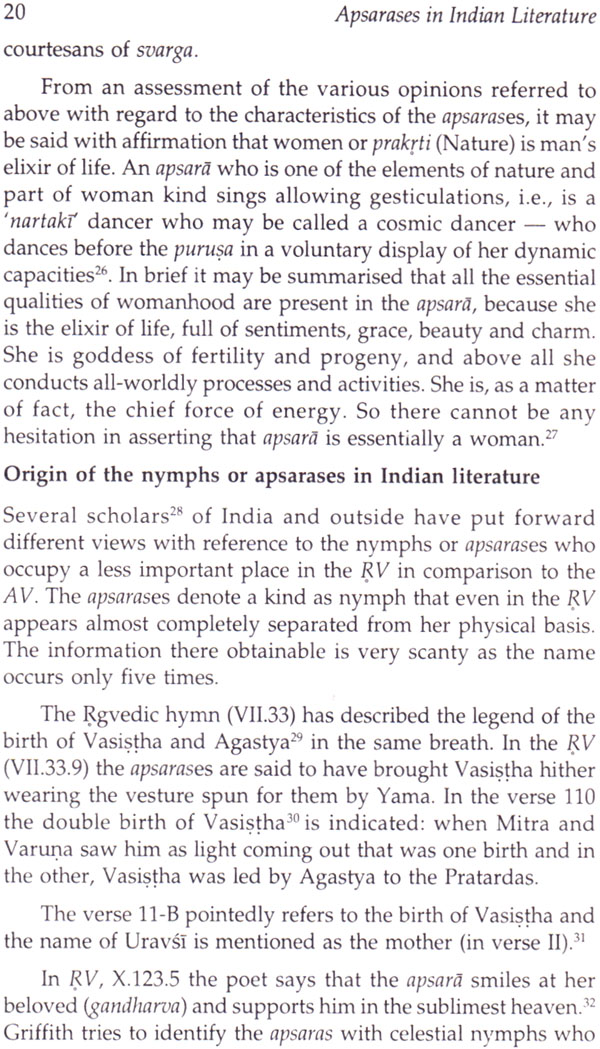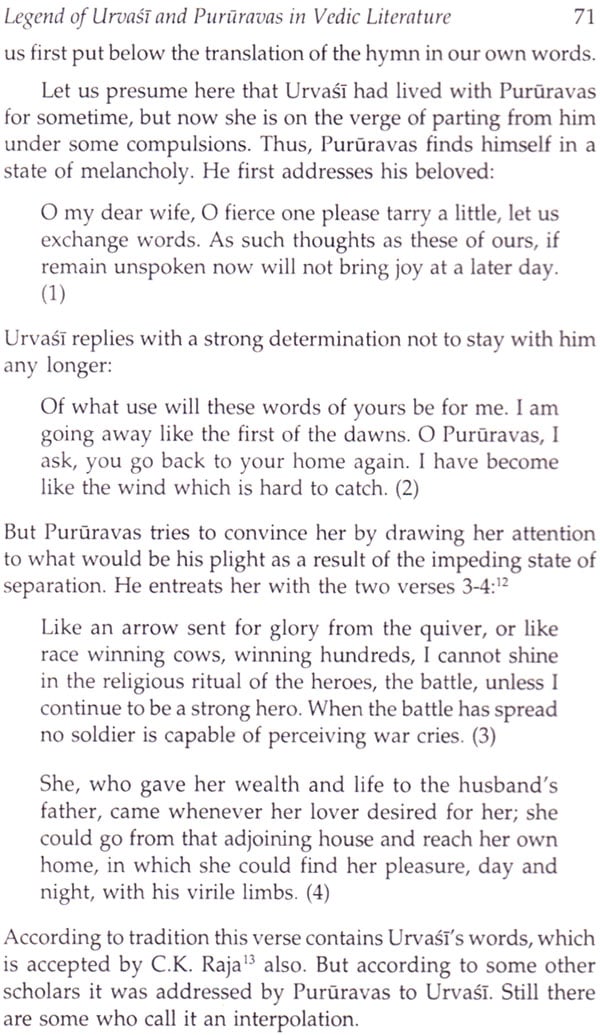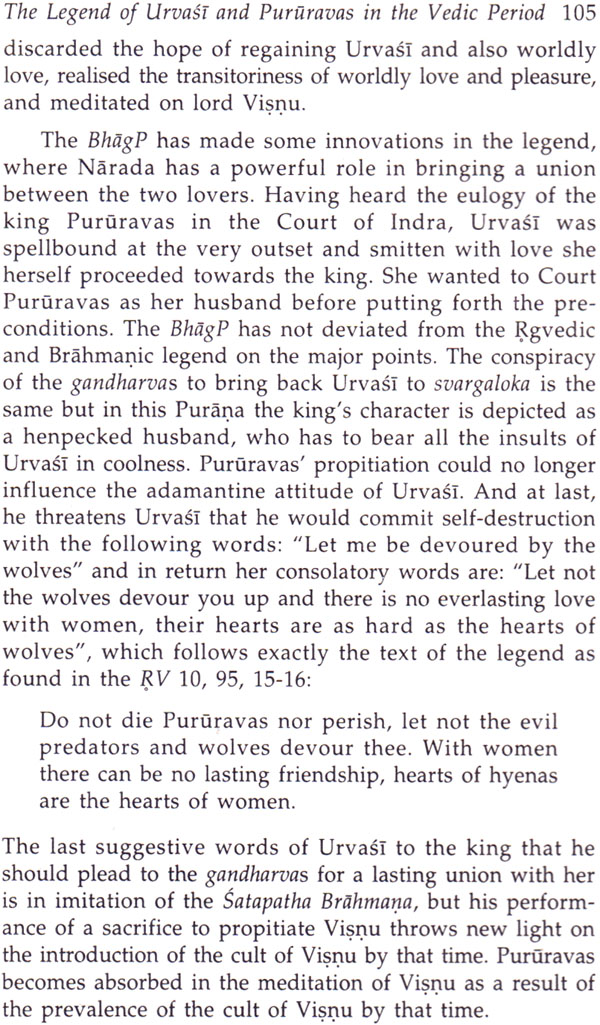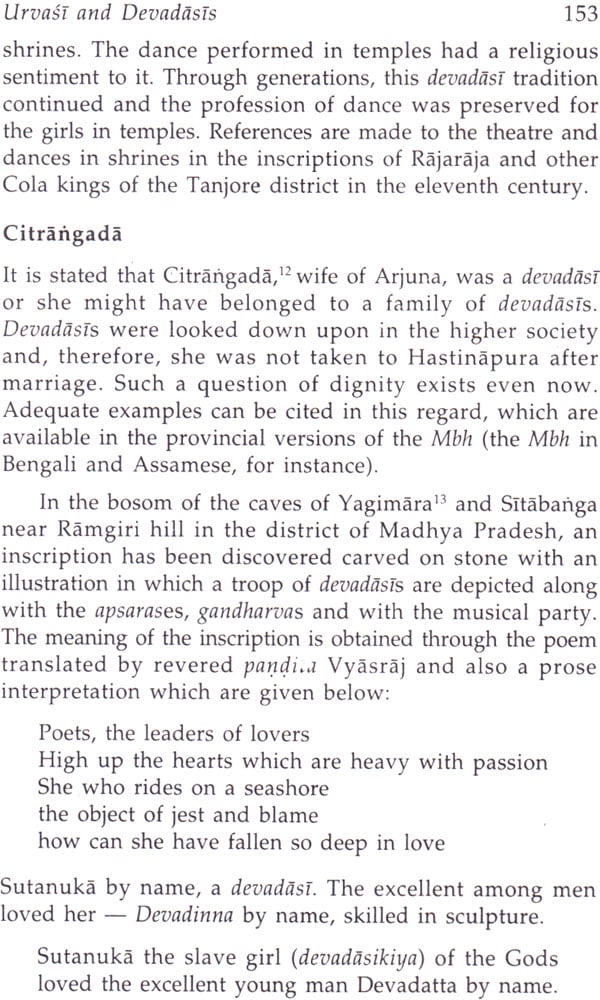
Apsarases in Indian Literature and the Legend of Urvasi and Pururavas
Book Specification
| Item Code: | IDD226 |
| Author: | Krishnakanta Handique |
| Publisher: | D. K. Printworld Pvt. Ltd. |
| Language: | English |
| Edition: | 2001 |
| ISBN: | 8186921168 |
| Pages: | 201 |
| Cover: | Hardcover |
| Other Details | 8.9" x 5.9" |
| Weight | 470 gm |
Book Description
From the Jacket
Indian literature abounds in a variety of myths and legends narrating allegorical/historical stories with moral teachings where celestial or semi-celestial beings, in particular the apsarases, occupy an important place. Of such legends, a few have become much popular and they reappear in the course of the history of literature at various stages. One such legend is that of Urvasi and Pururavas which is one of the most ancient legends of India, owing its origin to the Rgveda.
This scholarly work, based on extensive original sources - primary, comprising ancient Sanskrit texts, commentaries and glosses and modern literary pieces, kavyas and plays, as well as critical writings on these original works, studies the origin and development of the institution of apsarases and their characteristics as described in the vast corpus of Vedic, Epic-Puranic and classical works. In this context, it undertakes an interesting survey of the concept of nymphs (apsarases) in Indo-European, especially Greek mythology. Dr. Handique then thoroughly examines the depiction of the legend of Urvasi and Pururavas - a favourite theme that has been immortalized in literary masterpieces in Indian literature as a whole: from the ancient Vedas and Puranas, the Harivamsa and Vikramorvasiyam to modern works like Urvasi Janani and Abhisapta Urvasi and stray poetic pieces.
Presenting anew angle to the study, the book attempts to explore aspects of an age old tradition that bears close affinity with the institution of the apsarases in terms of mode of living worship and ideals - like system of the devadasis.
The book will prove invaluable to scholars of Indian mythology, culture and literature as well as interest general readers of ancient India's legends and tales.
About the Author
Dr. Krishna Kanta Handique is a reputed scholar of Sanskrit and folk literature who has presented research papers and represented the country in world conferences. His published works are Dvatrsaputtalika, Nagananda, Drama by Sriharsa, Uduyana: Vasavadutta and Bohe Brahmadaka Bhedi.
THIS book on presents a study of the popular traditional legend of Pururavas and Uravasi in some detailed form. It pays adequate attention to the origin, development and characte- ristics of the apsaras or 'nymphs' in Indo-European and Indian works. Lastly, it tries to deal with the social problem of the devadasis of a later age.
I was greatly helped and inspired by my friend, philosopher and guru Dr. Thaneswar Sarmah, the seniormost Reader in the Sanskrit Department, Gauhati University in the course of my research. I am greatly indebted to him and I shall ever remain grateful to him.
Besides, my siksa-gurus Dr. M.M Sharma, Dr. A.K Goswami, Dr. A.c. Barthakuria and Dr. R.N. Sharma also encouraged me to undertake this work and strive diligently towards its completion. I am thankful to all of them. I thank my erstwhile teacher Sjt. Ramchandra Bhattacharya, my associates in the department and my colleagues Dr. Akan Chandra Saikia, Dr. Pradip Gogoi, Prof. Jatin Bora, Prof. Guna Baruah, and Prof. Namal Gogi of Tinsukia College, my student and colleague Mrs. Anupama Mahanta, Prof. Chitralata Phukan, Head of Assamese Department of our college for their encouragement. I would like to mention here the librarians of the K.K Handique Library, G.U., and J.B. College Library and also Dimbeswar Sarma, a teacher of Narmal School, Jorhat, who helped me procure books for study. I am much indebted to my family members for their constant support.
MYTHS and legends, stories and anecdotes allure the minds of not only the masses but also intellectuals and scholarly persons. Through the ages human imagination has given rise to a vast literature replete with myths and legends, wherein the free thought of men finds easy expression. Sometimes, absurdities surpass the dictates of rationality, only to evoke or rouse interest in the human mind. But that does not prevent the listener or reader from enjoying the myths or legends. Therefore, myths and legends are accepted on all hands irrespective of barriers of caste, creed, race and ethnic group. Thus, every language culture preserves this sort of literature from over ages. And the Indians are no exception to it; rather they have preserved a vast literature abounding with myths, legends, stories, parables, tales and narratives. In fact, no other literature can claim equal footing with Indian literature where this literary form is concerned.
Myths and legends are abundantly found in the folk literature of any and every nation. It forms a component part of the folk culture. The older generation conveys this form of art and literature to the younger generation. The younger folks lend their attentive ear to learn the many myths and legends from their elders. Thus, this piece of literature is carried forward from generation to generation.
The themes of myths and legends are varied. On many occasions, the historical pieces intrude into it. Sometimes, the allegorical stories relating to animals, birds and such other lower beings have hidden moral teachings. Fantasies too, connected with absurd activities of the celestial or semi-celestial beings, find a place in such myths and legends. The apsarases, gandharvas, vidyadharas and kinnaras occupy an important place in such myths and legends in Indian literature. In all stages of Indian literature beginning from the Rgveda down to modern literature, fantastic myths and legends about gods and demi- gods are abundantly found. Some legends become so appealing to the people that the same legend reappears at various stages of the literature, repeatedly changing its outer form and assuming new attire. The legend of Pururavas and Urvasl appears to be such a piece for it has continued to be a favourite theme throughout our literature. It is, of course, very interesting to follow the course of such a legend and study the same, making a note of all elements, original and peripheral, new innovations and so on relating to such a legend. With that end in view, the legend of Pururavas and Urvasi is now undertaken for a detailed study.
| Preface | v | |
| Abbreviations | xi | |
| 1 | INTRODUCTION | 1 |
| Part I | Apsarases in Indian Literature | |
| 2 | ORIGIN AND DEVELOPMENT OF APSARASES ORIGIN OF THE NYMPHS IN INDO-EUROPEAN | 13 |
| Literature | 13 | |
| Characteristics of nymphs | 15 | |
| Apsarases' relation with the gandharvas | 16 | |
| Origin of the nymphs or apsarases in Indian literature | 20 | |
| Apsarases in the Ramayana: Post-Vedic period | 23 | |
| The Apsarases in the Mahabharata | 35 | |
| The Apsarases in the Puranas | 42 | |
| Apasarases in the Katha Literature | 47 | |
| Apsarases in the Kath-sarit-sagara | 48 | |
| Part II | The Legend of Urvasi and Pururavas | |
| 3 | LEGEND OF URVASI AND PURURAVAS IN VEDIC LITERATURE | 69 |
| The dialogue hymn of the RV, 10.95 | 70 | |
| Urvasi and Pururavas in the YV | 77 | |
| Urvasi: One of the female seers of the Vedic mantras | 78 | |
| Urvasi-Pururavas: Akhyana theory | 79 | |
| The legend is an allegory | 79 | |
| The dramatic element in the legend | 79 | |
| A love legend | 79 | |
| Analysis of the word, 'Urvasi' and 'Pururavas' | 80 | |
| Urvasi and Pururavas in Brhaddevata | 80 | |
| Urvasi and Pururavas in Nitimanjari | 81 | |
| Urvasi and Pururavas in Vedarthadipika | 82 | |
| 4 | THE LEGEND OF URVASI AND PURURAVAS IN POST-VEDIC PERIOD | 89 |
| Urvasi and Pururavas in Ramayana | 89 | |
| Urvasi and Pururavas in the Mahabharata | 90 | |
| Urvasi and Pururavas in the Puranas | 96 | |
| Urvasi and Pururavas in the Harivamsa | ||
| Urvasi and Pururavas in the Katha-sarit-saara | 114 | |
| Urvasi and Pururavas in the Upapuranas | 116 | |
| Urvasi in the holy places | 118 | |
| Urvasi in the fairy tales | 118 | |
| Urvasi: Incarnation of Durga | 120 | |
| Urvasi and Pururavas in Vikramorvasiyam of Kalidasa | 121 | |
| 5 | LEGEND OF URVASI AND PURURAVAS IN MODERN LITERATURE | 133 |
| Urvasi Janani | 133 | |
| Urvasi: Ramdhari Singh Dinakar | 137 | |
| Abhisapta Urvasi | 142 | |
| 6 | URVASI AND DEVADASI | 149 |
| Temples and devadasis | 151 | |
| Citrangada | 153 | |
| Devadasi: Profession prevailed in Kerala | 154 | |
| Evidence of devadasis and Siva temples | 155 | |
| Devadasi and Sankaradeva | 156 | |
| Yogini Tantra and devadasi | 156 | |
| Ahom queen Phulesvari was originally a devadasi | 157 | |
| The origin of Bharat Natyam | 158 | |
| Madhava Kandali's Ramayana | 158 | |
| Devadasi: A holy tradition | 158 | |
| Devadasi: Social evils and Indian women | 159 | |
| Devadasi: Source hailed from Western countries | 159 | |
| 7 | CONCLUSION | 165 |
| Appendices | ||
| 1. Genealogy of the Lunar Race | 169 | |
| 2. An alphabetical list of apsarases | 181 | |
| Bibliography | 183 | |
| Index | 191 |









